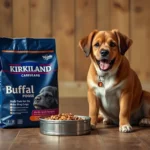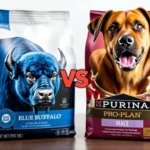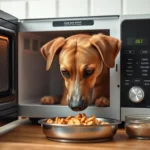
Introduction
Balanced nutrition is essential for the health and wellbeing of both dogs and cats. However, pet owners often face the challenge of how to keep your dog out of your cat’s food. Dogs are notorious for being attracted to cat food, which can lead to various health issues for both pets. Addressing this behavior is crucial not only for the health of the pets involved but also for maintaining harmony within the household. In this article, we will delve into the nutritional differences between dogs and cats, explore the reasons dogs are drawn to cat food, and provide effective strategies to keep your dog away from your cat’s meals.
Understanding Dog and Cat Nutrition
Differences in Nutritional Needs
Dogs and cats have distinctly different dietary requirements, primarily due to their evolutionary backgrounds. While dogs are omnivores, cats are obligate carnivores. This means that cats require a diet rich in animal-based proteins and fats, while dogs can thrive on a more varied diet that includes vegetables and grains.
- Dogs need:
- Protein: About 18-25% of their diet, depending on their age and activity level.
- Fat: 8-15% of their diet, providing energy and essential fatty acids.
-
Carbohydrates: While not strictly necessary, dogs can benefit from a moderate amount of carbohydrates for energy.
-
Cats require:
- Protein: Approximately 25-30% of their diet, as they need more protein than dogs.
- Fat: 20-30% of their diet, which is crucial for energy and nutrient absorption.
- Carbohydrates: Cats have a limited ability to digest carbohydrates, thus requiring much less than dogs.
Understanding these differences is vital for ensuring each pet receives appropriate nutrition.
Consequences of Dog Eating Cat Food
If a dog consistently eats cat food, there can be several short-term and long-term health consequences.
- Short-term effects might include:
- Upset stomach: Dogs may experience nausea or diarrhea after consuming cat food.
-
Vomiting: The rich composition of cat food can lead to vomiting, especially if ingested in large quantities.
-
Long-term health risks include:
- Obesity: Cat food is calorie-dense, and regular consumption can lead to weight gain in dogs.
- Pancreatitis: The high fat content in cat food can trigger pancreatitis, a painful and potentially severe condition.
By understanding these nutritional differences and health risks, pet owners can better manage their pets’ diets.
Why Dogs are Attracted to Cat Food
Smell and Taste Preferences
One primary reason dogs are drawn to cat food is its smell and taste. Cat food is often formulated to be highly palatable, with a higher protein and fat content than dog food. This rich aroma and flavor can be irresistible to dogs, whose sense of smell is significantly more acute than that of humans.
Moreover, dogs are natural scavengers. Their instincts drive them to seek out food sources, and the presence of another pet’s food can trigger that instinct, leading to attempts to steal cat food.
Behavioral Reasons
Curiosity is a natural trait in dogs, and the presence of cat food can stimulate this behavior. Additionally, competition among pets can cause dogs to view cat food as a coveted resource. Stress or anxiety can also lead to food-stealing behaviors, as dogs may seek comfort in eating.
Understanding these behavioral motivations can help pet owners develop strategies to mitigate the problem.
Effective Strategies to Keep Your Dog Away from Cat Food
Feeding Practices
Establishing good feeding practices is one of the most effective ways to manage your dog’s interest in cat food.
-
Designated feeding areas: Create specific feeding zones for both pets. Keep the cat’s food in a separate area that is less accessible to the dog.
-
Scheduled feeding times: Rather than free-feeding, provide meals at specific times. This helps control when food is available, making it easier to monitor both pets during mealtime.
-
Using elevated feeding stations: Cats often eat better from elevated feeders, which can deter dogs from reaching the cat’s food.
Training Your Dog
Training your dog can significantly reduce their interest in cat food. Here are some effective techniques:
-
Basic obedience commands: Teach commands such as “leave it” or “no” to discourage your dog from going after the cat’s food. Consistent reinforcement of these commands can help instill good behavior.
-
Positive reinforcement techniques: Reward your dog for ignoring the cat’s food or remaining in their designated area during mealtime. Treats and praise can reinforce these desired behaviors.
Establishing clear boundaries through training will contribute to a more harmonious feeding environment.
Creating Physical Barriers
If feeding practices and training do not resolve the issue, consider implementing physical barriers:
-
Utilizing pet gates or barriers: These can prevent your dog from accessing the area where the cat’s food is located.
-
Using dog-proof cat food containers: Invest in containers designed to keep dog snouts and paws out while allowing easy access for your cat.
Physical barriers serve as an effective line of defense against food-stealing behaviors.
Alternative Solutions
Switching Cat Food
Sometimes, adjusting the type of cat food can help alleviate the problem. Consider the following:
-
Recommendations for dog-safe cat food options: Look for cat foods that are lower in fat and calories and potentially less appealing to dogs. Consult with your veterinarian for recommendations tailored to your pets’ specific needs.
-
Consulting with a vet: If you suspect your dog has developed a habit of stealing cat food, discussing dietary adjustments with a veterinarian can provide insights into maintaining both pets’ health.
Providing Sufficient Nutrition for Dogs
Ensuring that your dog receives adequate nutrition can reduce their desire to seek out cat food:
-
Fully satisfying meals: Make sure that your dog is getting enough food at mealtime. A well-balanced diet that meets their nutritional needs will help keep them full and less likely to scavenge.
-
Importance of a well-balanced dog diet: Dogs should have a diet rich in quality proteins, healthy fats, and carbohydrates to sustain them. This can significantly diminish their attraction to cat food.
By addressing nutritional needs, you can help keep your dog satisfied and focused on their own food.
Monitoring and Adjusting Strategies
Observing Behavior
After implementing various strategies, it is essential to observe your dog’s behavior:
-
Keeping track of interaction: Note how often your dog attempts to eat cat food and under what circumstances. This information can help you fine-tune your approach.
-
Adjusting feeding strategies: Based on your observations, you may need to modify feeding times, locations, or barriers to ensure both pets can eat peacefully.
Regular Vet Check-ups
Regular veterinary check-ups play a crucial role in monitoring your pet’s health:
-
Discussing dietary concerns: Ensure that you keep your veterinarian informed about any issues related to your dog’s interest in cat food. They can provide guidance and support.
-
Monitoring health issues stemming from diet: Regular vet visits can help identify potential health problems early, allowing for timely interventions.
Monitoring your pets’ health and behavior is key to maintaining their wellbeing.
Conclusion
In summary, understanding the nutritional differences between dogs and cats is crucial in addressing the issue of how to keep your dog out of your cat’s food. By recognizing the reasons behind this behavior and implementing effective feeding practices, training, and barriers, pet owners can promote a healthier environment for both pets. Regular observation and veterinary check-ups will further ensure that both your dog and cat remain healthy and happy, fostering harmony in your household.









